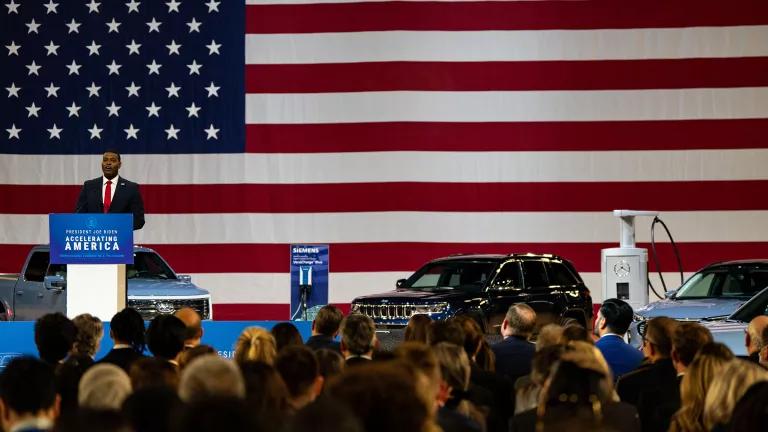Clean Trucks Yield $35 Billion in Benefits for Pennsylvanians
A new study shows that the Advanced Clean Trucks Program can bring $35 billion in benefits to Pennsylvania.

Photo by Quintin Gellar from Pexels
Pennsylvania has an important opportunity to provide significant air quality, health, and economic benefits to its residents by adopting the Advanced Clean Trucks (ACT) standard.
Under this standard, medium and heavy-duty vehicle (MHDV) manufacturers will sell increasingly higher percentages of new zero-emission vehicles (ZEVs) in each model year (MY) as a proportion of total new vehicle sales, based on the vehicle classes. Starting in MY 2027, class 2b-3 (heavy duty pickups and vans) and class 7-8 (heavy-duty tractor trailers) will have 15% new ZEV sales, while class 4-8 (box trucks, buses, day cabs) will have 20% new ZEV sales. Under a full ACT rule, manufacturers will need to sell 40% new class 7-8 as ZEVs, 55% new class 2b-3 as ZEVs, and 75 percent class 4-8 as ZEVs by MY 2035. Under ACT, ZEVs include battery electric vehicles, plug-in hybrid electric vehicles, and fuel cell electric vehicles.
A new analysis from ERM, commissioned by the NRDC (Natural Resources Defense Council), and the Union of Concerned Scientists (UCS), shows the significant potential public health, environmental, and economic benefits that adopting the full ACT program could bring to Pennsylvania under different scenarios.
Policy Scenarios
The report evaluated the following scenarios:
- Baseline: All new trucks sold in the state continue to meet US EPA’s latest NOx emission standards and ZEV sales increase only marginally, never reaching more than 1.2 percent of new vehicle sales each year.
- ACT Rule: Pennsylvania starts implementing ACT in MY 2027, and vehicle manufacturers sell an increasing percentage of new trucks in the state as ZEVs.
- 100 x 40 ZEV + Clean Grid: In addition to adopting the ACT Rule, Pennsylvania takes further actions to ensure more rapid and continued increases in new ZEV sales, such that virtually all new trucks are ZEV by 2040. In addition, an aggressive federal Clean Energy Standard is assumed to ensure that electricity generation in the state is carbon free and 100 percent zero-emitting by 2040.
Public Health and the Environment
Compared to the Baseline scenario, by 2050 the 100 x 40 ZEV + Clean Grid scenario is estimated to reduce annual MHDV fleet NOx emissions by 84% and PM emissions by 82%. The impact on Pennsylvania residents cannot be understated. This would deliver much cleaner air and better health for all residents: The resulting cumulative public health benefits for the two scenarios between 2027 and 2050 include 140 to 308 fewer premature deaths, 131 to 287 fewer hospital visits, and 71,760 to 151,791 fewer minor cases of illness. The value of these public health benefits totals between $1.8 billion and $4.1 billion.
Compared to the Baseline scenario, under the ACT scenarios cumulative greenhouse gas (GHG) emission reductions from Pennsylvania’s light-duty fleet reach between 202 and 367 million metric tons of CO2e from 2027 through 2050. The benefits of these GHG emissions reductions are valued at $4.8 billion to $15 billion.
Economic Impacts
For all years considered in the analysis, the average MHD ZEV in Pennsylvania will save the fleet owner between $9,000 and $17,000, depending on class, in lifetime costs compared to a conventional MHDV.
By 2050, under the ACT and 100 x 40 ZEV + Clean Grid scenario, annual net utility revenue from MHD ZEV charging is projected to be $381.9 million $565.5, respectively.
Since ACT will likely increase utility net revenue as it electrifies Pennsylvania’s MHDV fleet, Pennsylvania’s average residential and commercial rates could be 3.5 percent lower by 2050. The average Pennsylvania household could therefore save $117 each year on its electricity bill, and the average commercial customer $582 each year.
The deployment of ZEV charging infrastructure will also bring substantial investments to the state. Implementing ACT will require up to 402,000 cumulative charge ports. Purchasing and installing these chargers will bring approximately $3.7 billion in cumulative investment by 2050.
Adopting ACT will result in a net increase of more than 3,500 jobs nationally by 2035. Average wages for the new jobs created are expected to be over 50 percent higher than average wages for the jobs that will be replaced.
Conclusion
Taken together, the cumulative net societal benefits by 2050 reach $24.9 billion under the ACT scenario and $35.2 billion under the 100 x 40 ZEV + Clean Grid scenario.
To fully capture the most benefits, Pennsylvania must adopt ACT before the end of this year so that it is implemented starting in MY 2027. This way, Pennsylvanians can fully receive the significant public health, climate, and economic benefits as the state transitions to a clean transportation system.



